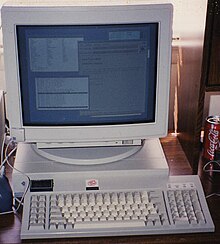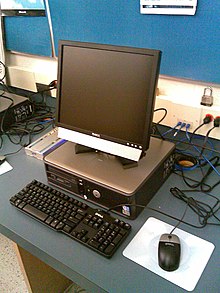Market and sales[edit]
See also: Market share of personal computer vendors
In 2001, 125 million personal computers were shipped in comparison to 48,000 in 1977.[16] More than 500 million personal computers were in use in 2002 and one billion personal computers had been sold worldwide from the mid-1970s up to this time. Of the latter figure, 75% were professional or work related, while the rest were sold for personal or home use. About 81.5% of personal computers shipped had been desktop computers, 16.4% laptops and 2.1% servers. The United States had received 38.8% (394 million) of the computers shipped, Europe 25% and 11.7% had gone to the Asia-Pacific region, the fastest-growing market as of 2002. The second billion was expected to be sold by 2008.[17] Almost half of all households inWestern Europe had a personal computer and a computer could be found in 40% of homes in United Kingdom, compared with only 13% in 1985.[18]
The global personal computer shipments were 350.9 million units in 2010,[19] 308.3 million units in 2009[20] and 302.2 million units in 2008.[21][22] The shipments were 264 million units in the year 2007, according to iSuppli,[23] up 11.2% from 239 million in 2006.[24] In 2004, the global shipments were 183 million units, an 11.6% increase over 2003.[25] In 2003, 152.6 million computers were shipped, at an estimated value of $175 billion.[26] In 2002, 136.7 million PCs were shipped, at an estimated value of $175 billion.[26] In 2000, 140.2 million personal computers were shipped, at an estimated value of $226 billion.[26] Worldwide shipments of personal computers surpassed the 100-million mark in 1999, growing to 113.5 million units from 93.3 million units in 1998.[27] In 1999, Asia had 14.1 million units shipped.[28]
As of June 2008, the number of personal computers in use worldwide hit one billion,[29] while another billion is expected to be reached by 2014. Mature markets like the United States, Western Europe and Japan accounted for 58% of the worldwide installed PCs. The emerging markets were expected to double their installed PCs by 2012 and to take 70% of the second billion PCs. About 180 million computers (16% of the existing installed base) were expected to be replaced and 35 million to be dumped into landfill in 2008. The whole installed base grew 12% annually.[30][31]
Based on International Data Corporation (IDC) data for Q2 2011, for the first time China surpassed US in PC shipments by 18.5 million and 17.7 million respectively. This trend reflects the rising of emerging markets as well as the relative stagnation of mature regions.[32]
In the developed world, there has been a vendor tradition to keep adding functions to maintain high prices of personal computers. However, since the introduction of the One Laptop per Child foundation and its low-cost XO-1 laptop, the computing industry started to pursue the price too. Although introduced only one year earlier, there were 14 million netbooks sold in 2008.[33] Besides the regular computer manufacturers, companies making especially rugged versions of computers have sprung up, offering alternatives for people operating their machines in extreme weather or environments.[34]
| Source | Date | Lenovo | HP | Dell | Acer Inc. | Asus | Others |
|---|---|---|---|---|---|---|---|
| IDC[35] | Q2 2014 | 19.6% | 18.3% | 14.0% | 8.2% | 6.2% | 33.6% |
| Gartner[36] | Q2 2014 | 19.2% | 17.7% | 13.3% | 7.9% | 6.9% | 35.0% |
Deloitte consulting firm predicted that in 2011, smartphones and tablet computersas computing devices would surpass the PCs sales.[37] As of 2013, worldwide sales of PCs had begun to fall as many consumers moved to tablets and smartphones for gifts and personal use. Sales of 90.3 million units in the 4th quarter of 2012 represented a 4.9% decline from sales in the 4th quarter of 2011.[38] Global PC sales fell sharply in the first quarter of 2013, according to IDC data. The 14% year-over-year decline was the largest on record since the firm began tracking in 1994, and double what analysts had been expecting.[39][40] The decline of Q2 2013 PC shipments marked the fifth straight quarter of falling sales.[41] "This is horrific news for PCs," remarked an analyst. "It’s all about mobile computing now. We have definitely reached the tipping point."[39] Data from Gartner Inc. showed a similar decline for the same time period.[39] China's Lenovo Group bucked the general trend as strong sales to first time buyers in the developing world allowed the company's sales to stay flat overall.[39] Windows 8, which was designed to look similar to tablet/smartphone software, was cited as a contributing factor in the decline of new PC sales. "Unfortunately, it seems clear that the Windows 8 launch not only didn’t provide a positive boost to the PC market, but appears to have slowed the market," said IDC Vice President Bob O’Donnell.[40]
In August 2013, Credit Suisse published research findings that attributed around 75% of the operating profit share of the PC industry to Microsoft (operating system) and Intel (semiconductors).[42]
According to IDC, in 2013 PC shipments dropped by 9.8% as the greatest drop-ever in line with consumers trends to use mobile devices.[43]
Average selling price[edit]
Selling prices of personal computers steadily declined due to lower costs of production and manufacture, while the capabilities of computers increased. In 1975, an Altair kit sold for only around US $400, but required customers to solder components into circuit boards; peripherals required to interact with the system in alphanumeric form instead of blinking lights would add another $2,000, and the resultant system was only of use to hobbyists.[44]
At their introduction in 1981, the US $1,795 price of the Osborne 1 and its competitor Kaypro was considered an attractive price point; these systems had text-only displays and only floppy disks for storage. By 1982, Michael Dell observed that a personal computer system selling at retail for about $3,000 US was made of components that cost the dealer about $600; typical gross margin on a computer unit was around $1,000.[45] The total value of personal computer purchases in the US in 1983 was about $4 billion, comparable to total sales of pet food. By late 1998, the average selling price of personal computer systems in the United States had dropped below $1,000.[46]
For Microsoft Windows systems, the average selling price (ASP) showed a decline in 2008/2009, possibly due to low-cost netbooks, drawing $569 for desktop computers and $689 for laptops at U.S. retail in August 2008. In 2009, ASP had further fallen to $533 for desktops and to $602 for notebooks by January and to $540 and $560 in February.[47] According to research firm NPD, the average selling price of all Windows portable PCs has fallen from $659 in October 2008 to $519 in October 2009.[48]
Terminology[edit]
"PC" is an initialism for "personal computer". However, it is sometimes used in a different sense, referring to a personal computer with an Intel x86-compatible processor, very often running (but not necessarily limited to) Microsoft Windows, which is a combination sometimes also called Wintel, although large portion of PCs are not shipped with preinstalled Windows operating systems. Some PCs, including the OLPC XOs, are equipped with x86 or x64 processors but not designed to run Microsoft Windows. "PC" is used in contrast with "Mac", an Apple Macintosh computer.[49][50][51][52] This sense of the word is used in the Get a Macadvertisement campaign that ran between 2006 and 2009, as well as its rival, I'm a PC campaign, that appeared in 2008. Since Apple's transition to Intel processorsstarting 2005, all Macintosh computers are now PCs.[53]
Types[edit]
Stationary[edit]
Workstation[edit]
Main article: Workstation
A workstation is a high-end personal computer designed for technical, mathematical, or scientific applications. Intended primarily to be used by one person at a time, they are commonly connected to a local area network and run multi-useroperating systems. Workstations are used for tasks such as computer-aided design, drafting and modeling, computation-intensive scientific and engineering calculations, image processing, architectural modeling, and computer graphics for animation and motion picture visual effects.[54]
Desktop computer[edit]
Main article: Desktop computer
Prior to the widespread usage of PCs, a computer that could fit on a desk was remarkably small, leading to the "desktop" nomenclature. More recently, the phrase usually indicates a particular style of computer case. Desktop computers come in a variety of styles ranging from large vertical tower cases to small models which can be tucked behind an LCD monitor. In this sense, the term "desktop" refers specifically to a horizontally oriented case, usually intended to have the display screen placed on top to save desk space. Most modern desktop computers have separate screens and keyboards.
Gaming computer[edit]
Main article: Gaming computer
A gaming computer is a standard desktop computer that typically has high-performance hardware, such as a more powerfulvideo card, processor and memory, in order to handle the requirements of demanding video games, which are often simply called "PC games".[55] A number of companies, such as Alienware, manufacture prebuilt gaming computers, and companies such as Razer and Logitech market mice, keyboards and headsets geared toward gamers.
Single unit[edit]
Further information: All-in-one computer
Single-unit PCs (also known as all-in-one PCs) are a subtype of desktop computers that combine the monitor and case of the computer within a single unit. The monitor often utilizes a touchscreen as an optional method of user input, but separate keyboards and mice are normally still included. The inner components of the PC are often located directly behind the monitor and many of such PCs are built similarly to laptops.
Nettop[edit]
Main article: Nettop
A subtype of desktops, called nettops, was introduced by Intel in February 2008, characterized by low cost and lean functionality. A similar subtype of laptops (or notebooks) is the netbook, described below. The product line features the new Intel Atom processor, which specifically enables nettops to consume less power and fit into small enclosures.
Home theater PC[edit]
Main article: Home theater PC
A home theater PC (HTPC) is a convergence device that combines the functions of a personal computer and a digital video recorder. It is connected to a TV set or an appropriately sized computer display, and is often used as a digital photo viewer, music and video player, TV receiver, and digital video recorder. HTPCs are also referred to as media center systems ormedia servers. The general goal in a HTPC is usually to combine many or all components of a home theater setup into one box. More recently, HTPCs gained the ability to connect to services providing on-demand movies and TV shows.
HTPCs can be purchased pre-configured with the required hardware and software needed to add television programming to the PC, or can be cobbled together out of discrete components, what is commonly done with software support from MythTV,Windows Media Center, GB-PVR, SageTV, Famulent or LinuxMCE.




